On a much-needed break from the first leg of his current tour with his road-tested Freedom Band, Ty Segall takes a seat in his mood-lit studio control room, mug of hot java in hand, and looks around with a visible expression of what can only be described as wonder. “You know, to have my own place to work on stuff is just pure joy,” he says. “I’m often like, ‘How did this even happen?’ It’s a great place to hone my skills and to get weird ideas going, with no pressure. The clock’s not running. We’re not burning a budget here. You get to do whatever you want. It’s just totally insane.”
Segall has made a career out of being prolific, so it was probably inevitable that he’d pool his resources into designing the three-room complex he calls Harmonizer, named for the album it spawned after he put the finishing touches on the studio build-out, completed in early 2021 at his home in the Santa Monica Mountains just outside Los Angeles. Compact but state-of-the-art, Harmonizer not only stands as testament to the long hours Segall has logged on his way to becoming an A-list producer, but it also plays a key role as an instrument in Segall’s arsenal that’s just as crucial to his sound as his trusty Travis Bean TB1000S or, more recently, his vintage Martin D-35 acoustic.
Ty Segall "Hello, Hi" (Official Visualizer)
Title track from "Hello, Hi", available on LP/CS/CD on July 22, 2022 from Drag City.Preorder now:https://ffm.to/tyhellohiAll three figured prominently, in fact, into the making of “Hello, Hi”—Segall’s latest studio realization of what he calls a “back to basics” album. “It was about coming back to the acoustic guitar, to be honest,” he clarifies. “I think a lot of the records I make have to do with my relationship to songwriting at that time. And I hadn’t really played the acoustic or written on it since probably Freedom’s Goblin, which at this point is maybe five years ago. So, to me it was really like falling back in love with the acoustic guitar. It was a very nice experience to have.”
If there’s a modern California sound—a throwback to the late-’60s Laurel Canyon “freak folk” vibes of the Byrds, Buffalo Springfield, and many more, but infused with a wild and rambunctious onslaught of psychedelic garage rock—then Segall’s music radiates it, and “Hello, Hi” might be the closest he comes to creating a West Coast “concept album” without openly admitting it.
From the lovely waking dissonance and pastoral colors of songs like “Good Morning,” “Blue,” and “Looking at You” to the thick, hard-knocking grooves of the title track and the sublime coda, “Distraction,” Segall touches on themes of reflection and connection that feel immediate, palpable, and deeply moving. It can be a bit of a nostalgia trip, but he pulls off the balancing act with well-wrought songs that convey a sense of longing without a trace of schmaltzy artifice.
“You know, to have my own place to work on stuff is just pure joy. “I’m often like, ‘How did this even happen?’”
At the heart of that authenticity is the Martin, which inspired Segall not only to write with renewed vigor, but also spurred him to get his hands on a microphone that could do it justice. “For all the records that I’ve done, I try to get one piece of gear, and that’s the expense of the record,” he explains. “This one was pretty crazy. I got a [Neumann] U67. That’s basically the guitar sound on the whole record.”
Among studio heads, the U67 is a legendary, and legendarily expensive, microphone that has been central to the sound of classic albums from the ’60s and ’70s, perhaps most notably Bob Dylan’s Highway 61 Revisited and Blonde on Blonde. The mic can harness a huge arc of low end without distorting, but it can also preserve an elusive and intimate “proximity effect” on vocals and acoustic instruments that has made it one of the most desirable, and essential, pieces of gear in any major studio.
“I couldn’t help myself with the wild-style production move on that one. You know, you’re at the restaurant and you’re like, ‘Ah fuck it, I’ll get the lobster!’”
The album’s closing suite of songs, beginning with the whimsically titled “Saturday (Part 1),” probably best signifies how Segall was able to use the U67 to his advantage. The opening acoustic filigree and Segall’s hypnotic vocal combine to recall vestiges of White Album-era Beatles, but with a startling presence and stereo imaging that creates a real under-the-skin sensation.
“Saturday (Part 2)” brings in the Freedom Band’s Charles Moothart on drums and Mikal Cronin on saxophone, with Segall on bass and electric guitar, gradually stoking a psychedelic heat that would take the Doors to task. When Cronin crashes into the mix with a horn solo that consists of two stacked takes, the in-your-face blast suddenly elevates the song to a completely different level.
Ty Segall’s Harmonizer Studio Gear
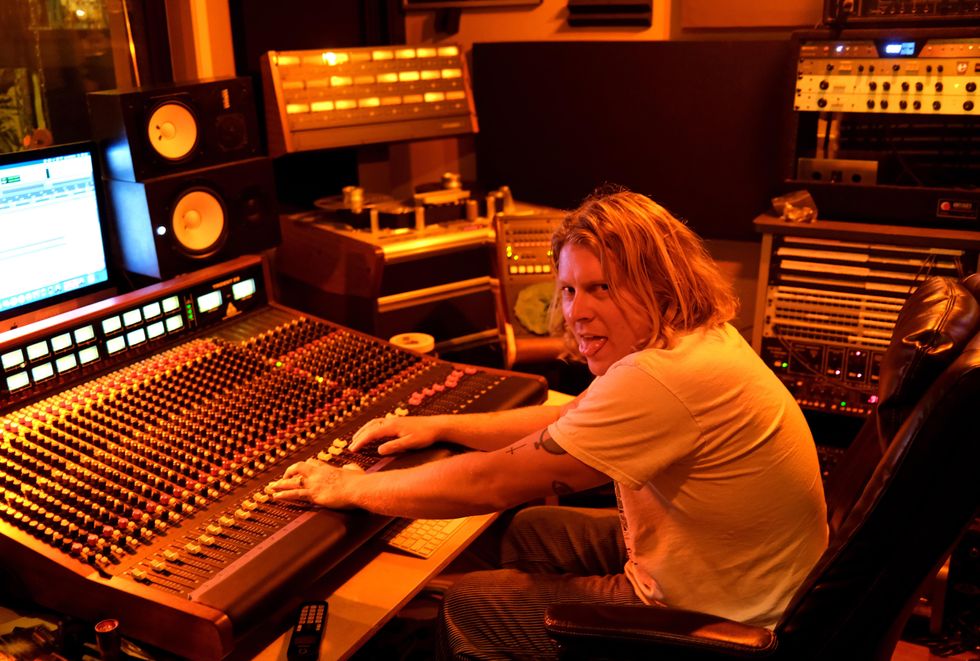
“The clock’s not running. We’re not burning a budget here. You get to do whatever you want. It’s just totally insane,” says Ty Segall about working in his own studio.
Photo by Denée Segall
Guitars
- Late-’70s Travis Bean TB1000S (tuned to D standard)
- ’69 Les Paul
- Vintage Martin D-35
- Gibson B-25 (for live shows)
- ’68 Gibson EB-0 bass
Amps
- Fender Quad Reverb
Effects
- Boss FZ-2 Hyper Fuzz
- Death by Audio Apocalypse, Fuzz War, and Octave Clang
- DOD Performer Flanger 575
- Electro-Harmonix Nano Small Stone
- Electro-Harmonix Sovtek Deluxe Big Muff Pi
- Moog Minifooger MF Delay
- Roland Space Echo RE-201
- Univox Super-Fuzz
Studio Console & Select Outboard Gear
Trident 88 Console (“Hello, Hi” was tracked on Segall’s TAC Scorpion Console, now retired)
Studer 2" tape machine (circa mid-’80s)
Ampex 351 Preamps (vintage)
Antelope Audio Orion 32 AD/DA audio interface
Electrical Audio EAPreQ
Eventide H949 Harmonizer (four units)
Highland Dynamics BG2 compressors
Normaphone custom preamps (designed by Greg Norman at Electrical Audio)
SPL Transient Designer
Universal Audio Classic 1176 Compressor (vintage)
Strings & Picks
- .011-gauge strings
- .88 mm picks (no preferred brand for either)
“I couldn’t help myself with the wild-style production move on that one,” Segall jokes. “You know, you’re at the restaurant and you’re like, ‘Ah fuck it, I’ll get the lobster!’ It was fun, and Mikal just obviously rips. He came over to the studio for maybe an hour, and after it I was like, ‘Amazing dude, thank you!’”
It’s worth mentioning here that Segall records almost obsessively to 2" tape, which lends another layer of analog thickness to “Hello, Hi” that isn’t easy to reproduce with a strictly digital setup (although he has recently started transitioning to hybrid digital-analog recording). “I demo on tape, which is insane,” he reveals, “but I do like the idea of burning over something if it’s not good. For me, keeping something bad is just a waste of tape. If there’s a cool idea there, rip a shitty mix to the computer so you have it, and then roll over it. I don’t want to be the kind of studio that has 50 reels just stacked in a corner, you know?”
Tape saturation plays a role in the Led Zeppelin II-like sound of the album’s closer, “Distraction,” which features Moothart channeling the ghost of John Bonham on drums, but the real secret sauce boils down to Segall’s ability to adapt as an engineer and producer.
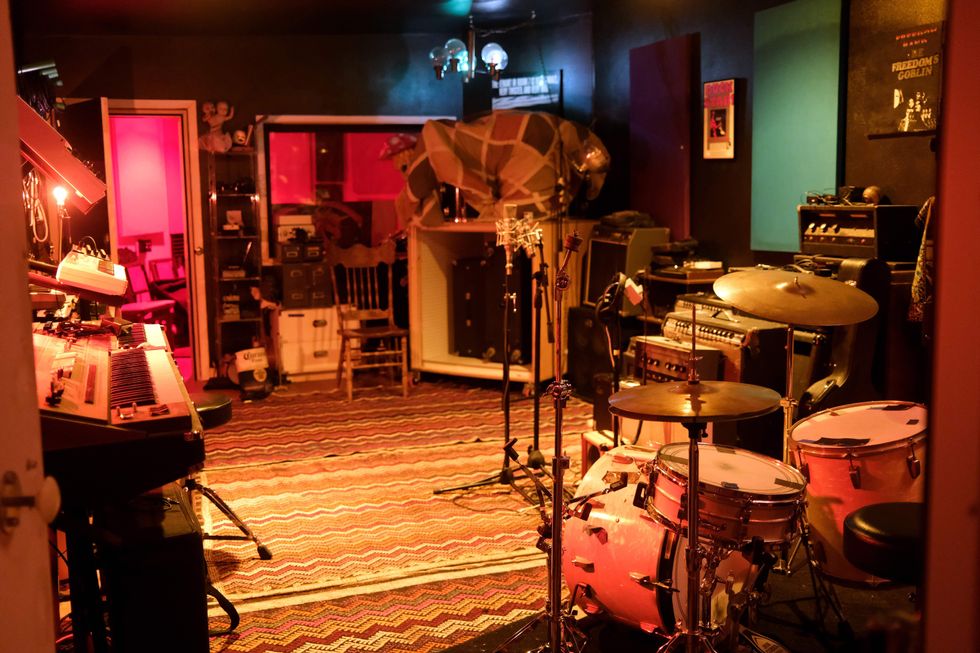
Ty Segall’s Harmonizer Studio was named after his 2021 album, which he was inspired to make after building out a three-room recording space in his home in the Santa Monica Mountains. Note his MVP Neumann U67 at center.
Photo by Denée Segall
“Like the rest of the record, as far as the writing went, it was a coffee-in-the-morning thing,” he says. “After the acoustic demo, I did the first version with Charles, and it sounded big and electric, but I miked the drums wrong and the room treatment was wrong, so I had to start from scratch.”
Moothart’s drum kit was set up in Harmonizer’s isolation room, which Segall retreated by adding more sound-deadening panels and stripping down the microphone scheme. “I just re-miked everything in a simpler way, and then I cooled off on the compression and EQ because I thought it would be a better vibe to not be so heavy-handed. And that was when I got my Trident [mixing console]. I took a whole day to mix it, which you don’t get in studios when you’re paying for time. So that song has three versions out there. That’s not rare for me. Some have three or four, because I’m constantly looking to redo something if it’s not right.”
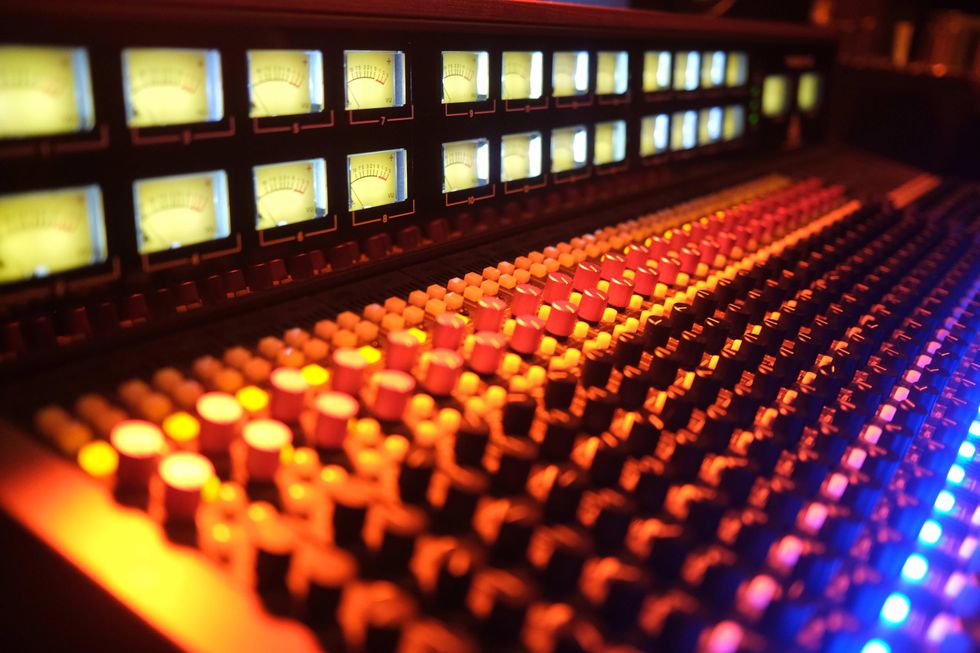
This Trident 88 Console is a new acquisition to Ty Segall’s Harmonizer Studio. “Hello, Hi” was tracked on a TAC Scorpion Console, which Segall has since retired.
Photo by Denée Segall
Segall held to simplicity when recording his beloved Travis Bean TB1000S, which he always routes through a beat-up Fender Quad Reverb. He comes back to the album’s moshpit-ready title song as an example. “I just felt like the record needed one ripper, so I picked that one and it worked,” he says.
“For me, keeping something bad is just a waste of tape. If there’s a cool idea there, rip a shitty mix to the computer so you have it, and then roll over it. I don’t want to be the kind of studio that has 50 reels just stacked in a corner, you know?”
He added a Boss FZ-2 Hyper Fuzz to the signal chain, giving the guitar an explosive sound that comes very close to peeling paint at the volume Segall usually plays. “That’s the U67 on almost everything except the bass. I mean, I have to say it again, that mic just makes it so easy to record the guitar. I always do the hand trick, where you spread out your fingers and place it about a hand’s width away from the speaker. Source and signal are not gonna hurt that mic—just turn it up and there it is. I think I used my Ampex for the mic preamp, but that’s it.”
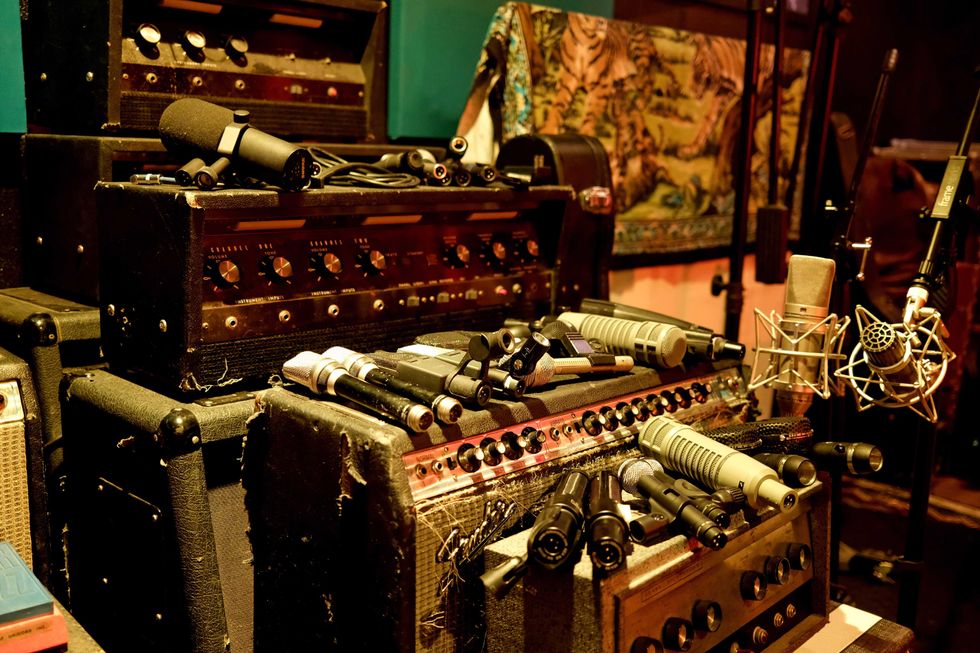
A Martin D-35 inspired Ty Segall not only to write with renewed vigor, but also spurred him to get his hands on a microphone that could do it justice. “The U67 really just changed the feeling of everything,” he says. “I always ended up going back to pointing it at the 12th fret, usually somewhere between six-to-eight inches away.”
Photo by Denée Segall
“Hello, Hi” is Segall’s 14th album in an unbroken stretch of feverish creativity that began in 2008 with his self-titled debut—an ultra-raw slab of sinewy protopunk surf garage that still holds its charms, but Segall is in a completely different headspace now.
“Sure, you know, it always feels great to get the sound you’re looking for,” he says. “Even though I just wanted to keep this one classic, I feel like there’s always a question mark until a record is out, and until you have time away from it. When I was fully finished with it, I wasn’t sure, but now that I’ve had some time apart from it, it is what it is. And I really love what it is.”
We’d still love to call it the first wave of a new California sound, but maybe that’s best left to the producer, too, until next time.
Ty Segall & Freedom Band - Full Performance (Live on KEXP)
In this recent KEXP studio concert, Ty Segall digs right into his Travis Bean TB1000S, introducing a full-on guitar feedback attack as the Freedom Band follows suit in the feverishly funky, fuzzed-out “Whisper,” from Segall’s 2021 album, Harmonizer.
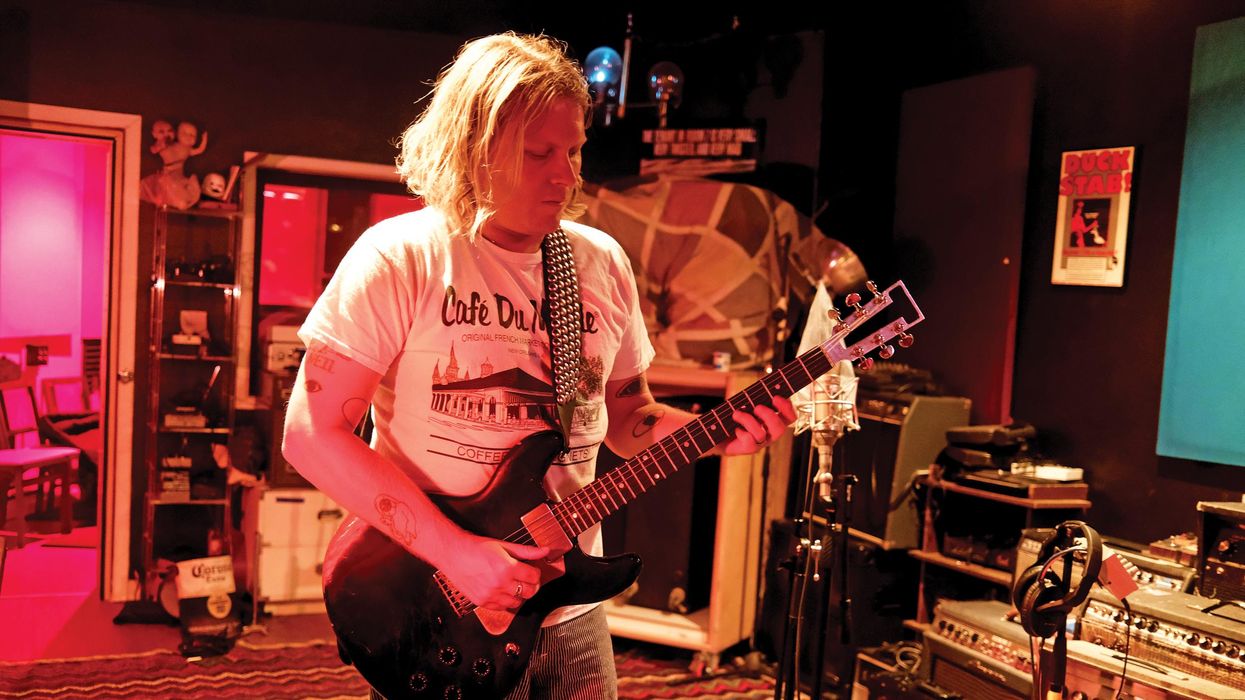












 Zach loves his Sovtek Mig 60 head, which he plays through a cab he built himself at a pipe-organ shop in Denver. Every glue joint is lined with thin leather for maximum air tightness, and it’s stocked with Celestion G12M Greenback speakers.
Zach loves his Sovtek Mig 60 head, which he plays through a cab he built himself at a pipe-organ shop in Denver. Every glue joint is lined with thin leather for maximum air tightness, and it’s stocked with Celestion G12M Greenback speakers.







![Devon Eisenbarger [Katy Perry] Rig Rundown](https://www.premierguitar.com/media-library/youtube.jpg?id=61774583&width=1245&height=700&quality=70&coordinates=0%2C0%2C0%2C0)











 Luis Munoz makes the catch.
Luis Munoz makes the catch.







